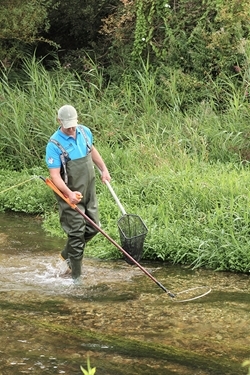 Declines in adult salmon on the River Frome witnessed in recent years show no sign of abating, according to the latest figures in a fisheries report.
Declines in adult salmon on the River Frome witnessed in recent years show no sign of abating, according to the latest figures in a fisheries report.
The latest Fisheries Research Review, published this week by the Game & Wildlife Conservation Trust (GWCT), shows that a disappointing number of adult fish returned to the river last year. It was hoped that a good number of smolts (young salmon leaving the river for their marine journey) in 2018 would boost these numbers, but far fewer returned to the river than expected.
One factor that might have contributed to this is size, with smolts leaving the river in 2018 the smallest ever recorded by the Trust – 4% smaller than the ten-year average. Previous research by the GWCT has shown that larger smolts are more than three times more likely to return from the sea than smaller ones. The worryingly low number of smolts that left the river in 2017 will also have had a major impact.
Despite these alarming findings, the fisheries ecologists at East Stoke, near Wareham, are working hard to understand the declines. 2019 and 2020 have been very busy years, beginning with smolt monitoring on the River Frome, 24 hours a day for six weeks. April and May were spent netting sea trout at sea, and in May, June and July the team worked on three rivers to recapture sea trout previously fitted with data storage tags. August and September were spent on the River Frome, catching and tagging 13,000 trout and salmon parr, and in December the team moved to the River Tamar where they caught and tagged sea trout kelts. Despite the impact of COVID-19 in 2020, the fisheries team enlisted their families to ensure the Frome was perhaps the only river in Britain to have full monitoring through lockdown. This dedication avoids a two-year gap in the data, as this year’s smolt will be monitored when they return as adults over the next two years.
Much of this work is part of SAMARCH, a multimillion-pound project that will provide crucial evidence to strengthen the management and protection of salmon and sea trout at sea over five years (2017 to 2022).
Finding the positives in a challenging year, David Mayhew, chairman of GWCT fisheries research steering committee, said: “Our fisheries team spent more time in the field last year than probably any other year in the last 10 years. Furthermore, two of our PhD students, Jessica Marsh and Jessica Picken, submitted their theses on the importance of instream vegetation for salmonids and the effect of low flows on salmonid ecosystems, respectively. A remarkable achievement.”
It is hoped that Jessica Marsh’s work will offer rare optimism for salmon numbers. She found that with increasing coverage of Ranunculus (the aquatic plant often known as water-crowfoot), not only did the density of salmon parr go up but so did their growth rate.
Rasmus Lauridsen, Head of GWCT Fisheries Research, is encouraged by the findings: “This work illustrates how important juvenile freshwater habitat is,” he notes. “It could provide us with a management tool to increase not only the production of juvenile salmon but also their growth rate in lowland rivers.”
Both PhD studies are featured in the report, along with two new studies. Dan Osmond, undertaking a PhD with Cardiff University and the University of Exeter, is examining the impact of metal pollution in British rivers, notably on brown trout, and Olivia Simmons is working on her PhD study with Bournemouth University, exploring the factors that determine when salmon migrate.
The review can be downloaded for free at www.gwct.org.uk/fisheriesreport.
Notes to editors
The Game & Wildlife Conservation Trust – providing research-led conservation for a thriving countryside. The GWCT is an independent wildlife conservation charity which has carried out scientific research into Britain’s game and wildlife since the 1930s. We advise farmers and landowners on improving wildlife habitats. We employ more than 60 post-doctoral scientists and other research staff with expertise in areas such as birds, insects, mammals, farming, fish and statistics. We undertake our own research as well as projects funded by contract and grant-aid from government and private bodies.
For information, contact:
Eleanor Williams
Telephone: 07592 025476
Email: press@gwct.org.uk